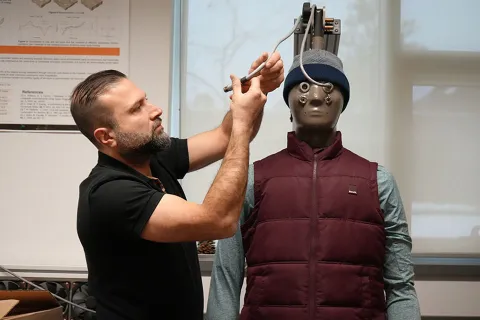New research improves the coolness factor for athletes

This article was originally published in UBC Okanagan News.
Weekend joggers, competitive athletes and people keeping fit in the gym can say goodbye to sweaty armpits and clingy damp garments after a tough workout.
Thanks to a new collaboration with Lululemon, UBC Okanagan researchers and their partners are working to develop a next-generation fabric that will keep a person warm, dry and comfortable regardless of temperature and level of exertion.
Creating a functional material that can address thermophysiological comfort—maintaining thermal regulation by the exchange of heat and moisture from the skin to the environment—has long been a goal of activewear companies, explained Dr. Farzan Gholamreza, lead author and coordinator of UBCO’s Cluster of Research Excellence in Comfort Enhancing Technologies.
“Over the past few decades, significant advances have been made in the sportswear industry to develop athletic apparel that has numerous characteristics to enhance comfort,” Dr. Gholamreza added. “Our latest research seeks to identify some key fabric properties that will bolster human comfort levels in active wear.”
Dr. Gholamreza and a team of researchers at the UBC Materials and Manufacturing Research Institute, along with researchers from the University of Alberta, University of Toronto and the Swiss Federal Laboratories for Materials Science and Technology, are investigating better ways to analyze how fabric systems react to body heat and moisture.
“Understanding how a material responds to the heat generated by the body is a vital component to developing fabrics that transfer sweat to the environment and cool the body,” said Dr. Abbas Milani, Professor of Mechanical Engineering and UBCO Principal’s Research Chair in Sustainable and Smart Manufacturing.
A physically active person generates heat that needs to be dissipated into the environment to maintain thermal balance. Perspiration also protects against overheating by dissipating heat from the skin through evaporation.
Failure to dissipate heat and moisture from the body may result in heat stress or heat exhaustion which can affect health and performance.
To take this research to the next level, testing devices such as sweating hot plates, cylinders and thermal manikins have been developed. Compared to human wear trials, these devices save time and money to calculate the thermophysiological comfort of textiles since the work is done in the lab, not on people.
With the help of a “sweating torso” UBCO researchers developed a numerical model to accurately measure heat and moisture transfer between the fabric and the user. This formula provides a basis to better understand how a fabric’s properties, environmental conditions and physiological parameters can work together to enhance overall comfort levels.
“Mathematical models combined with the simulation of the sweating torso have demonstrated that the model could help predict the comfort properties of fabrics including initial cooling, sustained cooling, cooling delay, moisture uptake and the drying time,” said Dr. Gholamreza. “Overall, the model is a helpful tool that can be widely used to predict how fabric systems protect the comfort of users under moderate to intensive physical activities.”
The research was published in the journal Materials and supported through the UBC Eminence Program.



